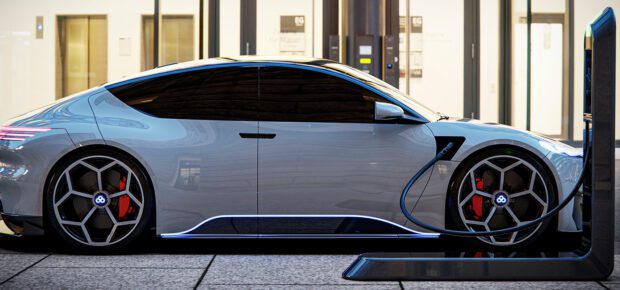April 6, 2023
Electric vehicles are seen as essential to the decarbonization of transportation. And they have seen immense gains in recent years. According to the International Energy Agency, sales of electric vehicles (EVs) doubled in 2021, and nearly 10% of vehicles sold worldwide were electric.
A new report from IEEE Access reviews more than 100 pieces of research – from academic papers to consumer surveys – to find out what policy makers and car companies can do to accelerate EV adoption.
Here’s what they found:
1. It’s probably no surprise, but the distance that an EV can travel on a full battery has a big impact on EV adoption. It was a barrier to purchase for 33% of German car buyers, and 22% of car buyers in the UK and China.
2. About 60% don’t trust the driving range estimate specified by EV manufacturers.
3. For daily driving, EVs have more than enough range. Research in India, the U.S., and several Scandinavian countries found that the average distance driven each day is less than 31 miles, or 50 km.
4. Batteries make up a significant proportion of the purchase price of a new electric vehicle. A 2020 survey found that 74% of buyers would be more willing to purchase an EV if given the option to buy one without the battery, assuming that it was possible to swap batteries and lease them.
5. Fast charging is essential. Research has found that a big proportion of drivers are willing to spend up to three hours charging a vehicle. But normal charging times for vehicles with a 180-mile driving range can exceed six hours. Fast chargers can cut that time to 30 minutes.
6. There’s a strong preference for charging at home. Peak charging at private charging stations is between 12 a.m. and 3 a.m. But public fast charging stations are busiest between 6 p.m. and 9 p.m.
7. The cost of EVs can impact adoption, but consumers are willing to absorb the cost if charging times are sufficiently fast.
8. Consumers are willing to absorb higher costs for a couple of other reasons. Some are swayed by the expected reduction in maintenance costs compared to internal combustion vehicles. There’s also a segment of consumers that will pay more to help pay for the development of new technology.
9. Some research has gone into just how much more consumers are willing to pay for certain features, like extended battery range or faster charging times. U.S. consumers willing to add approximately $113 to the purchase price of a new vehicle for each additional mile of expected range.
“Adoption of EVs will accelerate only through lowering of their purchase price along with increased range and widespread availability of fast charging,” said Bilin Aksun-Guvenc, an IEEE member whose research focuses on automotive technology.
Aksun-Guvenc notes that there are a number of technologies waiting in the wings to help extend the range of EVs, including the eco-approach and eco-departure technologies, which integrate vehicle sensors with traffic control systems to encourage energy-saving driving habits.
“The most prominent way to extend the range of an EV is to reduce its acceleration. Repeated sudden acceleration and deceleration result in the largest changes in battery state of charge,” Aksun-Guvenc said.
This may mean changing the way a vehicle’s onboard computers interpret the pressing of the brake or the gas pedal.
Get involved: The transportation industry is going electric. It’s drawing on a wide range of expertise to do it. To support the transition, IEEE is forming the Transportation Electrification Council to bring together experts and technologists from around the world.






 Liquid Infrastructure: Our Planet's Most Precious Resource
Liquid Infrastructure: Our Planet's Most Precious Resource The Impact of Technology in 2025
The Impact of Technology in 2025 Quantum and AI: Safeguards or Threats to Cybersecurity?
Quantum and AI: Safeguards or Threats to Cybersecurity? Why AI Can't Live Without Us
Why AI Can't Live Without Us Bits, Bytes, Buildings and Bridges: Digital-Driven Infrastructure
Bits, Bytes, Buildings and Bridges: Digital-Driven Infrastructure Impact of Technology in 2024
Impact of Technology in 2024 Emerging AI Cybersecurity Challenges and Solutions
Emerging AI Cybersecurity Challenges and Solutions The Skies are Unlimited
The Skies are Unlimited Smart Cities 2030: How Tech is Reshaping Urbanscapes
Smart Cities 2030: How Tech is Reshaping Urbanscapes Impact of Technology 2023
Impact of Technology 2023 Cybersecurity for Life-Changing Innovations
Cybersecurity for Life-Changing Innovations Smarter Wearables Healthier Life
Smarter Wearables Healthier Life Infrastructure In Motion
Infrastructure In Motion The Impact of Tech in 2022 and Beyond
The Impact of Tech in 2022 and Beyond Cybersecurity, Technology and Protecting Our World
Cybersecurity, Technology and Protecting Our World How Technology Helps us Understand Our Health and Wellness
How Technology Helps us Understand Our Health and Wellness The Resilience of Humanity
The Resilience of Humanity Harnessing and Sustaining our Natural Resources
Harnessing and Sustaining our Natural Resources Creating Healthy Spaces Through Technology
Creating Healthy Spaces Through Technology Exceptional Infrastructure Challenges, Technology and Humanity
Exceptional Infrastructure Challenges, Technology and Humanity The Global Impact of IEEE's 802 Standards
The Global Impact of IEEE's 802 Standards Scenes of our Cyber Lives: The Security Threats and Technology Solutions Protecting Us
Scenes of our Cyber Lives: The Security Threats and Technology Solutions Protecting Us How Millennial Parents are Embracing Health and Wellness Technologies for Their Generation Alpha Kids
How Millennial Parents are Embracing Health and Wellness Technologies for Their Generation Alpha Kids Space Exploration, Technology and Our Lives
Space Exploration, Technology and Our Lives Global Innovation and the Environment
Global Innovation and the Environment How Technology, Privacy and Security are Changing Each Other (And Us)
How Technology, Privacy and Security are Changing Each Other (And Us) Find us in booth 31506, LVCC South Hall 3 and experience the Technology Moon Walk
Find us in booth 31506, LVCC South Hall 3 and experience the Technology Moon Walk Virtual and Mixed Reality
Virtual and Mixed Reality How Robots are Improving our Health
How Robots are Improving our Health IEEE Experts and the Robots They are Teaching
IEEE Experts and the Robots They are Teaching See how millennial parents around the world see AI impacting the lives of their tech-infused offspring
See how millennial parents around the world see AI impacting the lives of their tech-infused offspring Take the journey from farm to table and learn how IoT will help us reach the rising demand for food production
Take the journey from farm to table and learn how IoT will help us reach the rising demand for food production Watch technical experts discuss the latest cyber threats
Watch technical experts discuss the latest cyber threats Explore how researchers, teachers, explorers, healthcare and medical professionals use immersive technologies
Explore how researchers, teachers, explorers, healthcare and medical professionals use immersive technologies Follow the timeline to see how Generation AI will be impacted by technology
Follow the timeline to see how Generation AI will be impacted by technology Learn how your IoT data can be used by experiencing a day in a connected life
Learn how your IoT data can be used by experiencing a day in a connected life Listen to technical experts discuss the biggest security threats today
Listen to technical experts discuss the biggest security threats today See how tech has influenced and evolved with the Games
See how tech has influenced and evolved with the Games Enter our virtual home to explore the IoT (Internet of Things) technologies
Enter our virtual home to explore the IoT (Internet of Things) technologies Explore an interactive map showcasing exciting innovations in robotics
Explore an interactive map showcasing exciting innovations in robotics Interactively explore A.I. in recent Hollywood movies
Interactively explore A.I. in recent Hollywood movies Get immersed in technologies that will improve patients' lives
Get immersed in technologies that will improve patients' lives